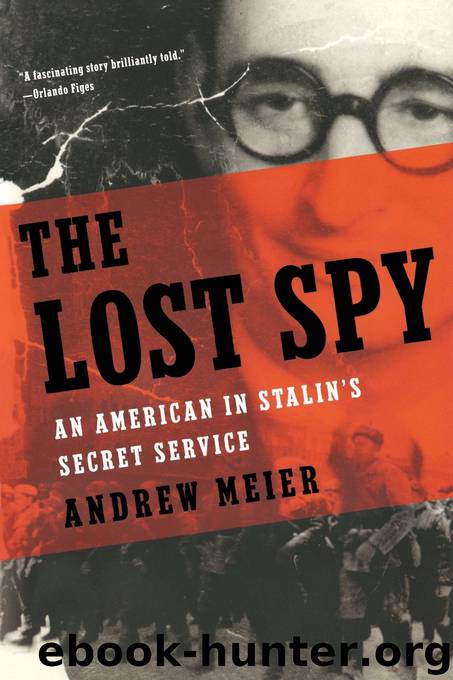The Lost Spy by Andrew Meier

Author:Andrew Meier
Language: eng
Format: epub
Publisher: W. W. Norton & Company
Published: 2008-01-01T05:00:00+00:00
A DOZEN YEARS EARLIER, LENIN HAD SENT A FAMED SOVIET AGENT TO China. Mikhail Markovich Borodin, a thirty-nine-year-old Comintern envoy and comrade of the father of the revolution, arrived in Canton in 1923. Born Gruzenberg to a Russian Jewish family in Byelorussia, Borodin had become a Bolshevik in his teenage years. He fought in the revolution of 1905, and after its failure spent more than a decade in exile in Chicago. In China, Borodin, with his outsized personality and fluent English, made fast friends—above all with Sun Yat-sen, the former doctor turned revolutionary who had founded the Kuomintang, the People’s Party. Sun at the time faced warlord satraps on all sides and could scarcely hold his party together. Lenin worried about the “virginal naiveté” of the Kuomintang leader, but saw in his party the potential for a bulwark against imperialism in Asia. Chiang Kai-shek, then Sun’s young head of staff and chief military strategist, was in Moscow on an extended stay when Borodin went to Canton in the fall of 1923. The exchange soon bore fruit: by 1924, Borodin had joined Sun’s inner circle of advisers.
After Lenin’s death, Stalin hoped to win over the Kuomintang, imagining that Borodin could bend both the nationalists and the Communists to Moscow’s will. The Comintern instructed the Chinese Communists to seek an alliance with Chiang, but after the death of Sun in 1925, any rapprochement was doomed. On March 20, 1926, Chiang cut short the coalition between the Kuomintang and the Communists, and then, when Borodin was absent from Canton, staged his coup. Within a year, the alliance ended in the 1927 massacre of Communists and Borodin’s humiliating retreat to Moscow. Stalin had gambled on forging a “revolutionary-democratic bloc” with the Chinese bourgeoisie, and lost.
The Soviet intelligence agencies only redoubled their efforts, sending a new wave of agents to China. In the late 1920s Shanghai became the operational arena of Richard Sorge, the Great Illegal, and his fellow spy and lover, Agnes Smedley. Smedley, the American writer and radical who had reported on Thälmann’s Red Front Fighters in Berlin, had gone to China directly from Germany. In Shanghai she worked officially as a correspondent for the Frankfurter Zeitung. Sorge relied on Smedley to introduce him to her wide circle of Chinese friends, including several who joined his network. The Center had made progress in establishing a Chinese underground, but by the time Cy arrived, Sorge’s old network was in ruins. Arrests and police raids had taken their toll.
The Settlement was blessed with a corps of British detectives, the elite of the Shanghai Municipal Police, the SMP. Their files, preserved in large part on sixty-seven microfilm reels in the records of the CIA at the National Archives, record the metropolis of vice in detail. The force resembled a racial pyramid, with Brits on top, Sikhs second, Russians third, and Chinese constables on the bottom. The SMP paid attention not only to the opium and sex trade but to the Soviet underground. A May 1933 report listed Sorge and Smedley as “suspected Soviet agents.
Download
This site does not store any files on its server. We only index and link to content provided by other sites. Please contact the content providers to delete copyright contents if any and email us, we'll remove relevant links or contents immediately.
| Africa | Americas |
| Arctic & Antarctica | Asia |
| Australia & Oceania | Europe |
| Middle East | Russia |
| United States | World |
| Ancient Civilizations | Military |
| Historical Study & Educational Resources |
Cat's cradle by Kurt Vonnegut(13868)
Pimp by Iceberg Slim(12932)
Underground: A Human History of the Worlds Beneath Our Feet by Will Hunt(11258)
4 3 2 1: A Novel by Paul Auster(11052)
The Radium Girls by Kate Moore(10908)
American History Stories, Volume III (Yesterday's Classics) by Pratt Mara L(4827)
Perfect Rhythm by Jae(4621)
Wiseguy by Nicholas Pileggi(4586)
The Fire Next Time by James Baldwin(4343)
Paper Towns by Green John(4169)
A Higher Loyalty: Truth, Lies, and Leadership by James Comey(4033)
Pale Blue Dot by Carl Sagan(4003)
The Mayflower and the Pilgrims' New World by Nathaniel Philbrick(3915)
The Doomsday Machine by Daniel Ellsberg(3731)
Too Much and Not the Mood by Durga Chew-Bose(3696)
Killers of the Flower Moon: The Osage Murders and the Birth of the FBI by David Grann(3609)
The Borden Murders by Sarah Miller(3590)
The Sympathizer by Viet Thanh Nguyen(3482)
Killing England by Bill O'Reilly(3455)
